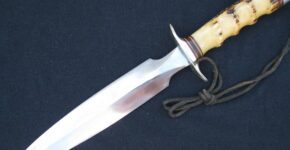

May 5, 2012 admin
Originally published in the RKS Newsletter #72 November 2006
The last issue’s article discussed a mid 1950’s era Bolo made by RMK. This issue’s article will cover an early 1970’s vintage Bolo. The subject of this article was originally introduced in RKS newsletter issue 21, February 1994. The article in issue 21 focused more on the history of this Bolo, but in this article while revisiting the history I am also going to present some elements about the design and construction of the blade. Note, if you don’t have a hard copy available of the original article, the InterSquare CD is an excellent source for older RKS newsletters.
The Bolo was originally made for Ralph Gaither in 1974. He had returned from Viet Nam where he had been a POW from 17 October 1965 to 12 February 1973 after being shot down during a bombing mission targeting a railroad bridge on the Red River 17 miles north of Hanoi. He was wearing a Randall model 1, sent to him by Bo with a note to pay when he could when he was shot down. His mission as a 23 year old “front seater” (pilot) of an F4 Phantom, was to protect the bombers from MIG’s and take out antiaircraft installations. He spent seven long years in a communist prison camp and wrote a book describing his ordeal titled “With God in a POW Camp”, Broadman Press, Nashville, Tennessee. An autographed copy of the book with a note or two accompanies the Bolo.
This Bolo is a special forging like the 1950’s model in last issue. Also like the 1950’s Bolo, this 1970’s Bolo is the only one like it made by Randall. The 01 steel blade is 10 inches long with an overall length of 14-5/6 inches and at its widest point 2 ¼”. The handle is the black micarta of the day. The micarta handle is epoxied on which is also standard for the time. A lined thong hole compliments the handle. The sheath is a rough backJohnson. Both Bolo and sheath are in excellent unused original condition.
Interesting to this Bolo is its full tang construction as you would find in the models 14, 15, 16, and 17 of the day. The stock of ¼” material along with the size gives the Bolo a weight of 1 lb, 8 oz., a full pound and a half !! This is one big and heavily built blade ready to tackle its intended purpose. The intended purpose is revealed in part by the inscription in the accompanying book, “Take care of my Randall Bolo, made especially for SERE training, USN.” SERE is an acronym for Survival, Evasion, Resistance, and Escape.
I spoke with Mr. Gaither about the design of the Bolo for some insight into how it came about. Mr. Gaither went to the shop in Orlando with his design and presented it to Bo and Gary sometime after he was released from the POW camp and returned to the USA. He also stayed in the Navy for another 12 years and commanded the US Naval survival school in San Diego. The Randall Bolo was a one off prototype he modeled after the bolo of the Philippine Negrito, an indigenous aborigine mountain people. Mr. Gaither had intended this to be a design he could incorporate into the SERE program as an issue survival knife. So in essence we have another “attempt” to incorporate an RMK as a US military issue knife, albeit a loose attempt at a specialized use knife and not a general issue item like the 14 and 15 submitted to the USMC in the mid 1950’s.
The design is interesting and is similar to the Special Forces “banana” knife of the Viet Nam era. You can compare the banana knife and the Gaither Bolo and see the similarities. In fact, there is one of the Special Forces models in the Randall Museum. This Randall Made Bolo is one of the most interesting Randall’s I have had the pleasure to examine much less own. It is truly a unique piece.
My conversation with Mr. Gaither was an experience to be remembered. He is a true American hero, a patriot, and a heckuva nice guy to boot. Mr. Gaither is known for sewing a small American flag out of a bandana given to him by his parents during his incarceration and scrap material he got in the prison camp. He told me he kept it well hidden from the communist guards and when possible he and his fellow POW’s would salute the flag and sing a patriotic song. If found he would have been severely beaten, but he and his fellow POW’s hung tough and did what they had to do to survive and keep the faith. At the close of my conversation with Mr. Gaither, all that was left for me to say was “Thank you for your service to the United States.”